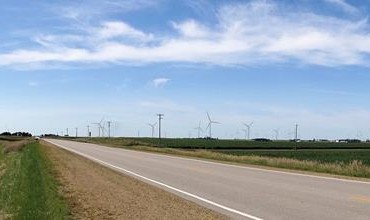Facebook, Google Tout Renewable Energy Projects

Big computing takes big energy. Two of the biggest computing entities on the planet, Facebook and Google, have revealed details of new renewable energy projects that they are involved with, which they say underscore their commitment to clean, renewable energy.
When Facebook announced its Altoona, Iowa datacenter this past spring, one of the promises it made was that Altoona would be among the most advanced and energy efficient facilities of its kind. Recently, Vincent Van Son, the data center energy manager at Facebook, detailed the progress that Facebook is making, saying that when the data center starts serving traffic in 2015, it will be supplied by 100% renewable energy from a new wind project in nearby Wellsburg, Iowa.
The Wellsburg wind farm project has been one that Facebook has been very closely tied with, having originally secured the rights to through its partner, RPM Access, a local wind project developer.
While Facebook originally secured the rights to have the wind farm built, it's not about to get into the wind farm business. “Facebook is not implementing or operating a wind farm,” Van Son told Enterprise Tech in an email exchange. “We secured the rights to a wind energy project in Wellsburg, Iowa, and transferred the rights to MidAmerican Energy (a local utility) to build, own, and operate it. We’ll track the relationship between the wind energy generated at Wellsburg with Facebook’s energy consumption using renewable energy certificates (RECs), which is an industry standard method that provides traceability and transparency.”
According to Van Son, the Wellsburg wind farm will contribute up to 138 MW of wind capacity to the grid in Iowa, “a direct result of Facebook’s decision to locate our data center in Iowa,” he says.
Meanwhile, Google has a renewable energy project of its own, literally cooking in the desert heat in California and Arizona. In 2011 Google made a $94 million investment in four solar facilities near Sacramento -- a project that annually produces 88 MW of solar capacity (enough to power 13,000 homes).
Google announced last week that it's doubling down on that project with a new $80 million investment with its global investment partner KKR that will culminate in six utility-scale solar facilities that will be distributed between the two states. The new solar farms, which will be installed by the solar developer Recurrent Energy, represent Google’s 14th investment in renewable energy, which Google’s Head of Corporate Finance, Kojo Ako-Asare, says represents more than $1 billion in total renewable energy projects around the world.
“These investments are all part of our drive toward a clean energy future – where renewable energy is abundant, accessible, and affordable,” explained Ako-Asare. “By continuing to invest in renewable energy projects, purchasing clean energy for our operations and working with our utility partners to create new options for ourselves and for other companies interest in buying renewable energy, we’re working hard to make that future a reality.”
The timing of these announcements makes for an interesting juxtaposition, and raises questions about whether one approach better than the other. We asked Van Son, who indicated that it’s a complex question that relies on several variables to answer.
“At Facebook, we look across all our operations to find opportunities to minimize our environmental footprint through energy and resource efficiency and to reduce cost,” he told Enterprise Tech. “Renewable resources are distributed differently across the world, so their cost competitiveness varies by location.”
“When we settled on Altoona as the location for our fourth data center,” he continued, “one of the deciding factors was the opportunity for us to help develop and bring about a new wind project in Iowa. The abundance of wind in the state enables a wind turbine to generate roughly twice as much energy as solar PV for each MW of generation capacity installed. Wind turbines also minimize the disruption to existing farmland since they have a smaller physical footprint and are often located along fence rows. These attributes help make wind energy an ideal renewable energy solution for Iowa.”
While Google can claim an investment edge in the pure dollar sense (if you were to look at this as a competition), it’s hard to downplay the innovations that Facebook is making, particularly where the datacenter is concerned. While it doesn't have solar farms at the size that Google has contributed, it has been involved with spot photovoltaic projects on their campus in Menlo Park, California, as well as in their cold storage data center in Prineville, Oregon. (Enterprise Tech took a look at this facility here).
Additionally, Facebook has contributed to energy efficiency through its Open Compute Project, which aims to drive efficiency in the data center from the inside-out.












